
| Volume 36 #6 | May/June 2020 | |
 |
Isn't it impressive, all the many ways people are using their phones and computers to stay in touch, to talk to each other, to "see" each other, even to dance with each other, in this time of enforced isolation?
Last month, the Branch Board held its first "remote" meeting. Using an app called "Zoom", each of us essentially joined the online meeting from our own computers or smart phones, in the comfort of our own homes. It took some experimentation, but we found that by speaking distinctly we could hear everyone, make motions, take votes, and generally transact our business. We were pleased (and relieved) with the results.
This encouraged the Board to decide to use Zoom for our Annual General Meeting! There will be an official announcement email to you all very soon, but the main points are: our AGM will be May 31 at 3:00 pm. Prior to the meeting, there will be a couple of emails to all members with the details about how to prepare for the meeting, how to sign in for the meeting, how to cast votes, etc.
Since that Board meeting, Tom and Liza have been holding "virtual dance classes" via Zoom, utilizing the time slot previously accorded to Liza's Challenge class. In addition to the many "locals" who attend, the first class was joined by a couple in Colorado!
The RSCDS has been emailing "Dance Scottish At Home", a weekly compilation of Scottish dance and music, podcasts, puzzles, an online class, and more. So far, I have been able to listen to only one of the podcasts, and it was very interesting and entertaining.
"This, too, shall pass." In the mean time, keep your chin up, "heels together!", "posture, please!", make strong Ws, and remember to close in third!
I hear that some folks stocked up on toilet paper. While I don't yet see the reason for such action, I can see how there might well be some satisfaction derived from getting the last rolls off the shelf just before the store closes its doors.
In early March, Susan and I flew to San Diego and attended the 45th Anniversary Dance hosted by the San Diego Scottish Country Dancers. This was their "Sapphire Ball", and I must say I've never seen so many shimmering sapphire blue dresses anywhere. Providing the music was the band, Reel of Seven, and it seemed that many of the dancers had followed the band down from San Francisco, while others were there from the Los Angeles area, Florida, and many parts of the Northwest.
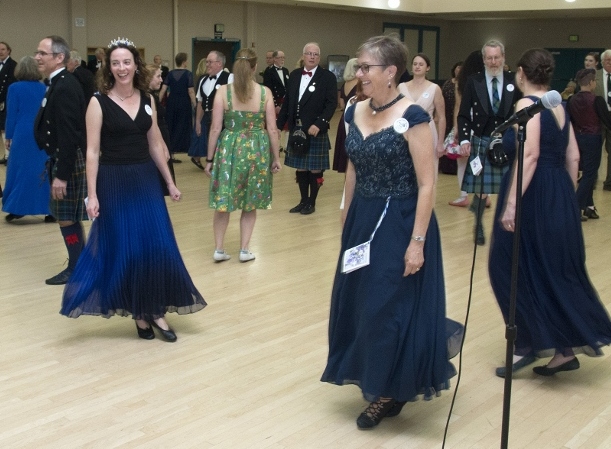 |
As you can imagine -- as you have probably experienced -- it was an amazing evening. Following the reception, we found places at dining tables that had been set up in the huge hall; then, by tables, we partook of a scrumptious catered buffet of salmon, chicken, and various salads and side dishes. (Yes, this event was a Dinner Dance!) The hall was so large that when dinner was concluded, the tables remained in place at their end of the hall and the dancing commenced in the center of the room.
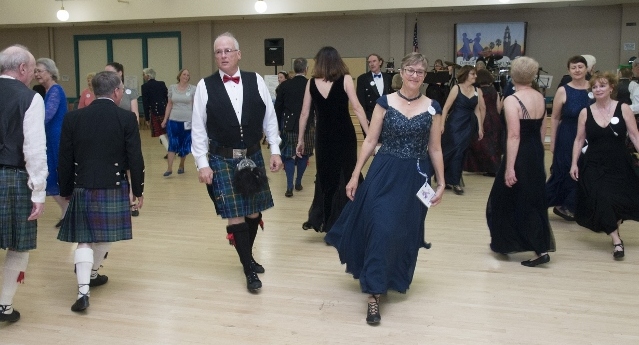 |
This pandemic, however, has quickly changed the dancing landscape. Within the week of our return to Vancouver, Portland had cancelled their annual workshop and ball, and within a few days of that, Southwest Washington decided similarly to cancel our own dinner dance -- tough, sad decisions at the time. These closures, and news of other cancellations around the SCD globe, have served to make the memories of that trip to San Diego all the more precious -- better even than just snagging the last rolls off the shelf before the store closes. At the same time, it has strengthened a determination that the "new normal" ahead of us will again include music, camaraderie, and the "controlled abandon" of Scottish Country Dancing.
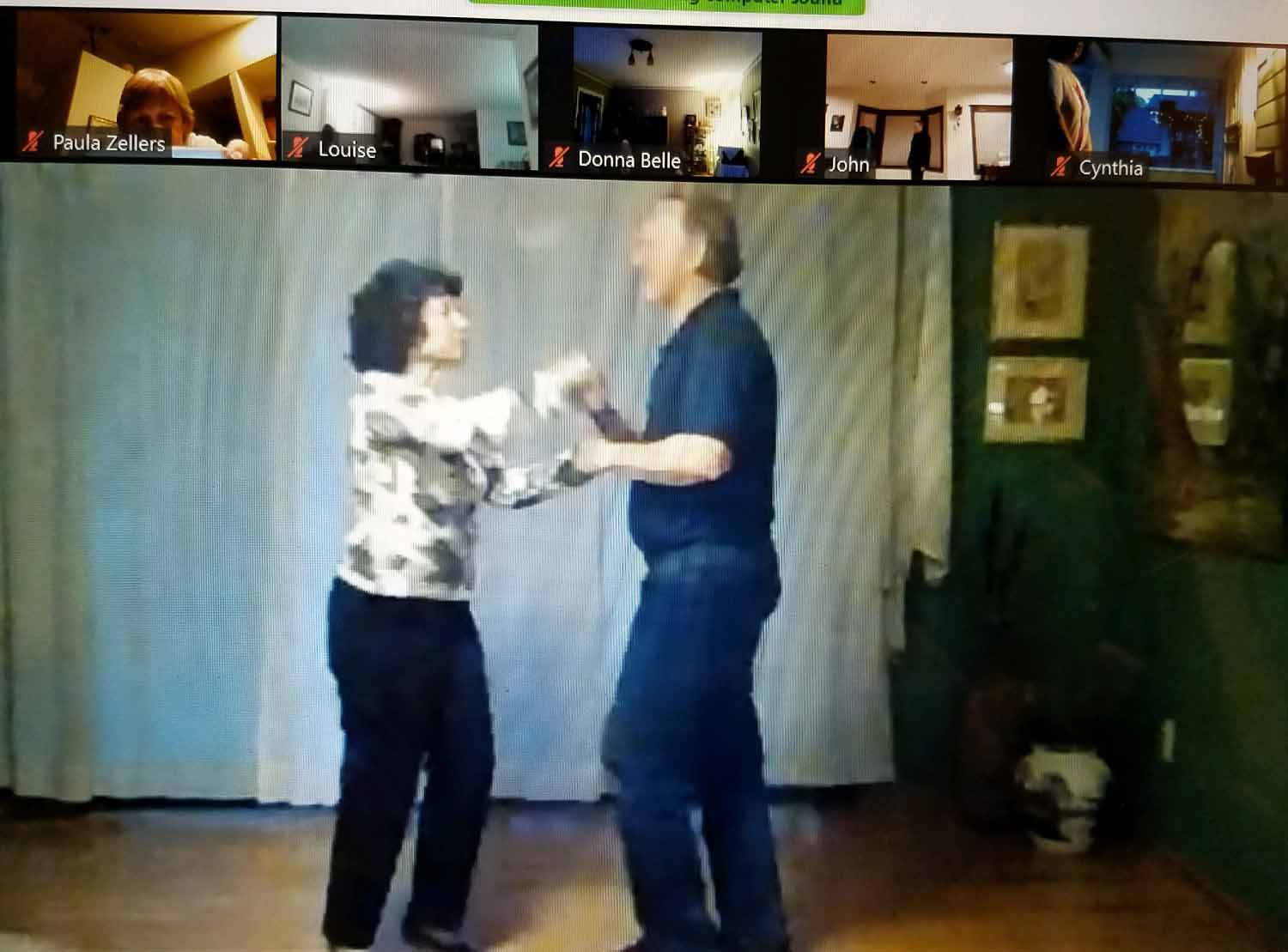 |
The COVID-19 pandemic has rapidly changed the world during the past two months. The situation first recommended social gathering in small groups with social distancing and frequent hand washing, then rapidly transitioned to everyone staying home except for essential workers in order to help the health care system manage a slower rate of new cases.
The Friday Scottish dance class met March 13 before all classes and dance events were suspended, with a "Socially Distant" format - some fun and easy dances with no touching. The March 14 Portland Branch workshop and ball event was canceled. We read that Scottish dance activities around the world were suspended around this time.
RSCDS created a "dance Scottish at home" web page and began emailing a weekly newsletter on Fridays titled Scottish Dance At Home. The aim is to have articles, music, games, podcasts and even online classes that will entertain and connect us with our dancing friends across the globe.
In order to keep the dancing going, Tom and Liza experimented with dancing the Portland ball program with ghost dancers in the dining room with furniture cleared out, using computer music over a few sessions. We then proceeded to similarly dance the canceled Dinner Dance program. Dances were generally danced four times instead of the usual eight times through. We danced three-couple dances in a four-couple set as 1st couple, 1st couple, 3rd couple, 2nd couple. For 3-couple dances in a 3-couple set, we danced each role according to the progression. Two-couple dances were danced as 1st couple, 2nd couple, 1st couple, 2nd couple.
We learned that a folk dance group was meeting online with the Zoom meeting platform, for a combination of dancing and social interaction between dances. RSCDS also planned to host a weekly online Scottish dance webinar on Zoom. So we had the idea to design the first Branch social distancing Scottish dance class online, based on the Social Dancing - Brief Only format with videos and cribs circulated ahead of time. Eighteen dancers attended the first online class April 7 with a combination of energetic dancing and social interaction between dances. We completed the dance program in a little over an hour with physical activity comparable to an in-person dance class. We used the remaining meeting time in conversation as therapy for our social isolation. We learned to share the computer-sound for participants to listen to good-quality dance music, compared with lesser-quality music transmitted through the microphone. However there is a delay between the sound and video image.
Online dancing with ghost dancers gives us lots of practice envisioning what the other dancers in our set are doing. Reading How to Dance from a Briefing (reprinted later in this issue), we observe that guideline number 3 might be more challenging while dancing with ghost dancers. "3. Make eye contact and keep it with your partner and with others in the set."
Lara Friedman-Shedlov from the RSCDS Twin Cities Branch gave an April 13 online presentation on topics
We can click the document links to learn about the topics.[The following address originally appeared in RSCDS London Branch newsletter The Reel - issue 16 - January-February 1954 , while Hugh Foss was both the branch chairman and newsletter editor, reflecting on variations in Scottish country dancing. Thanks to alert reader Tom Halpenny for sending this in. ~Ed]
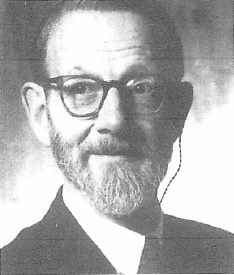 |
Ladies and Gentlemen, this is no ordinary Annual General Meeting, and I am sure you will forgive me if my thoughts overrun the customary thirty seconds allowed to the Chairman.
It is, as you all know, just 250 years since the Society was formed. To commemorate its quarter-millennium, Book 200, to be published this year, will be a deluxe edition with a handsome thought-transference ball of real cairngorm instead of common crystal. In addition to giving you the usual quota of twelve new dances we have added thoughts on fifty old favourites, some of them even older than the Society itself. These thoughts, I must emphasise, give the final and definite physical and mental versions of the dances as they are to be performed anywhere on Earth.
The news from our branches on Venus is encouraging. You will remember their perennial complaints about the shortage of male dancers, and how the shortage of female dancers was almost as bad. A year ago, 90 percent of their members were neuters. The Venusian males and females are addicted to a form of dancing -- if it can be called dancing -- whose tradition and purpose is very different from ours. During the past year, however, several Branch Secretaries report a much greater interest on the part of males and females. We welcome this new interest, but have urged all our Venusian teachers to guard against the introduction of unorthodox variations.
And now for Mars. Our Martian members have made two requests. The first is to introduce a variant of the reel of three, the grand chain and one or two other figures. So many Martians have turned from their own dances to Scottish Country Dancing that the dancehalls are packed and they have to find some means of saving space. Our Central Council have therefore decided to permit, as an optional variant, the reel of three in a vertical plane. In the Eightsome, for instance, the centre person begins the reel by jumping over his or her partner, who in turn jumps over the third person in the reel. Similarly in the Grand Chain the women begin by jumping over their partners and so on, under and over, until the chain is completed. Those of you who were fortunate enough to see our agile friends, less hampered by gravity than we are, in their last television performance will surely agree that these variations completely accord with the spirit of the dance.
The second Martian request is to introduce a figure they call the quadrifoil of eight. It is a common figure in Martian Cube Dances, and is believed to be a development of the Scottish trefoil of six, invented some 200 years ago. The quadrifoil of eight involves two dancers, passing right shoulder, leaping crosswise over two other dancers, also passing right shoulder. The Central Council have given the matter their very careful consideration, but regret that they cannot allow any dance containing this figure to be called a Scottish Country Dance. The over and under reel of three was permitted because of its similarity to our flat reel, but nothing like the quadrifoil of eight could ever be danced in Scotland.
And now, leaving the inner planets, we are glad to report the formation of our first branch on an outer planet. It is on Saturn, where the favourite -- and so far the only -- dance is The Dashing White Sergeant. As television from Saturn is very indistinct you may be interested to hear how the dance is performed. Each Saturnian takes the part of three Earth dancers. His arms, as most of you know, are in front of his forelegs, and his head is set half-way between his forelegs and middlelegs. In The Dashing White Sergeant dancers travelling clockwise round the room have their heads towards the centre, and those meeting them their heads to the outside.
The first eight bars are easy: to perform the circle, each dancer takes hold of the tail of the dancer meeting him in his right hand. The next eight bars are more difficult: the forelegs and middlelegs set to each other, and, so to speak, turn each other clockwise. After the middlelegs and hindlegs have set to each other, to get the Saturnian straight again, the hindlegs turn under counter-clockwise.
The dancer begins the reel of three by going under himself between his middlelegs and hindlegs, and then raising his hindlegs over. The Branch Secretary tells us that a controversy is raging as to whether the hindlegs should go in front of or behind the head. We have given our official opinion that either is correct, but that we think it would be against the spirit of the dance for the legs to go one on each side of the head.
At the end of the figure the dancers travelling clockwise make an arch under their heads, and those meeting them go under the arch.
I will conclude by thinking how much we all look forward to the day, not far distant, I hope, when the invention of a space ship will make it possible for us to meet and dance with our members on other planets instead of having to confine our contacts to telepathy, television, and the still unsatisfactory medium of telesaltation.
Being able to dance from a briefing (talk through) is a very useful skill. It will enable you to enjoy dancing in circumstances where you might not know the dances on a program and where you will receive only a briefing.
Briefings serve two functions: 1. They remind dancers of dances they already know. 2. They allow dancers to dance some straightforward dances they don't know.
Concentrate on the first first, but keep in mind that the objective as an experienced dancer is to get to the second.
We all have our preferred learning Style: visual, auditory, or kinesthetic. Good teachers teach in all three. Briefing is mostly a spoken communication, so while we as dancers should try to learn in more than one style, the fact remains that Scottish Country Dancing is most usefully conveyed to us in the auditory style. How then can we best prepare ourselves to effectively learn in this manner? Here are some guidelines:
1. Learn dancing, not dances. In addition to foot and upper body technique, learn figures (another aspect of technique). Learn them as chunks. So when a briefer says. "Rights and lefts," you have it -- cold. Most dances have at least two or three standard figures with perhaps just one you have to concentrate on. Get used to concentrating where you need to concentrate.
2. Practice interpreting the auditory message into your preferred Style. If you're visual, visualize it. If you're kinesthetic, feel it (Maybe drawing with your hands will help.) Emphasize to your teacher that drawing a figure on the blackboard, a flipchart, or a piece of scratch paper is a helpful method of achieving comprehension for some students and a confirmation of understanding for others.
3. Make eye contact and keep it with your partner and with others in the set. You can give each other reminders and cues. When in doubt, feel free to ask, "What's next?"
4. If you miss something, it's usually best to let it go and just be in place for the next figure. If you forget hands across, don't join it in the wrong position. Wait for the hands back or the next figure. If you miss the turn before a cast, just cast.
The RSCDS "Dance Scottish At Home" newsletter invited dancers to post responses to weekly questions on social media. Following are my responses to a couple of personal topics, from consulting the Branch's historical archive of newsletters.
The March 19, 2020 RSCDS #ThursdayChallenge asked: How did you start dancing?
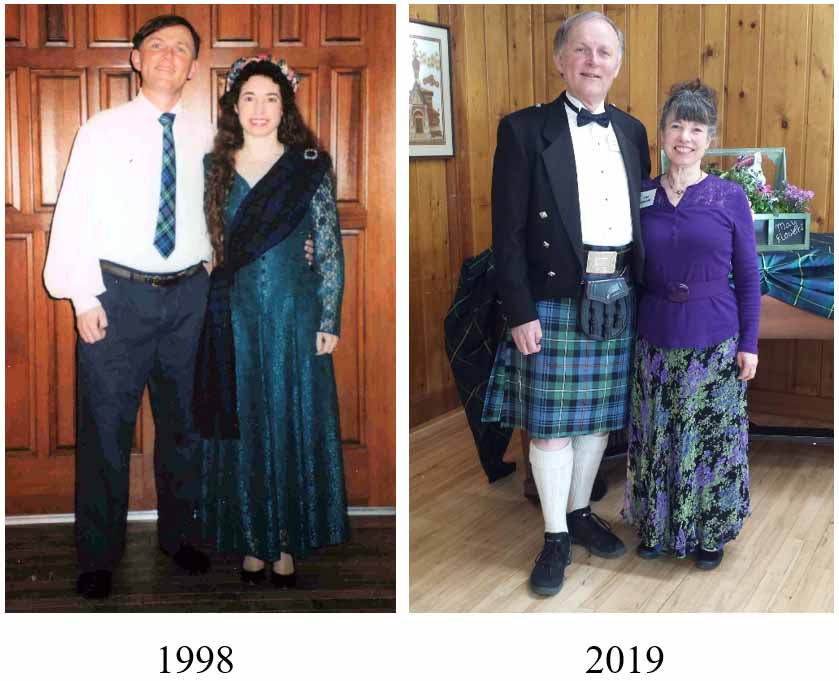 |
"I have been working extra long hours this year at HP, an average of 10 hours per day, on a new printer which will be introduced next spring, so I have not had a great deal of time for many interesting personal activities. However, Liza has had the wisdom to get us both to participate in the local Scottish Country Dancing class, beginning last spring. We had first been introduced to SCD during a vacation trip to Victoria British Columbia two years ago. Liza took Kat and Hannah to a beautiful nearby park with gardens with duck ponds and an outdoor theater; I came to find them an hour later. I first found K & H chasing the ducks in the duck pond, and I could hear some music nearby. So I continued on to investigate the music, which brought me to the theater, where some sort of folk dancing was taking place. Upon closer scrutiny, I realized that Liza was an active participant, so I sat down to watch. When the current dance was finished, one of the 30 or so dancers approached me, and before I knew what was happening I was now part of the group. I recall being able to half-way learn the steps so that I could get through the dances which followed. It was a fun time for us, so two years later, Liza tracked down the Scottish Country Dancing group in our town, and we were enrolled in the class.
"As with all activities which we have done together, Liza was able to learn the dance skills faster than I could. We have a wonderful teacher who is able to adapt the weekly dance lessons to the current skills of the participants. She explains things very clearly, and gives everyone encouragement. I became aware of how disconnected my left and right brains are. The teacher would walk us through the steps of a dance and my left brain could absorb it. But when she turned on the music to dance the steps, my right brain could not seem to remember how to do the steps. After enough repetition, I am now able to dance more confidently. I know the difference between a Jig, Reel, and Strathspey, and I am now finally able to do the basic formations, some of which are called Skip Change, Pas de Basque (Setting), Poussette, Figure-8, Rights-and-Lefts, Back-to-Back, Wheel, Left- & Right-Shoulder Reel of Three. In addition, I have become the editor of the group's bimonthly newsletter, with three published issues under my belt."
* Journal of a Beginning Scottish Dancer
The April 16, 2020 RSCDS #ThursdayChallenge asked: What was your first big Scottish country dancing event?
Our first dance was the 1997 Fall Fiesta with dance titles more familiar to me now than they were then.
The February 1998 Dinner Dance was our first big SCD event. The group's co-founder and promoter Fred van Nus managed to attract over 120 public observers to view our Scottish dancing and listen to the music. In a separate session before the event, Fred had provided an accelerated class to help us learn the dances, and he introduced us to the Pilling-diagrams memory device.
*Fall Fiesta Dance Brings Out Señores here
*Annual Dinner Dance is Fan-tastic here
Calendar of Events | ||
|
|